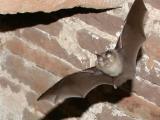Two studies exploring potential reservoirs for MERS-CoV found evidence that the virus is widespread in camels in Nigeria but not in bats in Egypt and Lebanon.
The Nigerian study, published today in Eurosurveillance, noted that RNA of MERS-CoV (Middle East respiratory syndrome coronavirus) indicated that the virus infecting camels there is distinct from strains in the Middle East, where most human cases have occurred. The virus has been previously identified in dromedary camels in the Middle East as well as in several African nations.
And in the bat study, published yesterday in Emerging Infectious Diseases, researchers identified other coronaviruses in various samples from wild bats, but not MERS-CoV.
About 95% of camels seropositive
For the camel study, researchers from Hong Kong and Nigeria studied nasal swabs and blood samples collected from dromedary camels shortly after slaughter at an abattoir in Kano, Nigeria. Some of the animals originated from northern Nigeria, as well as from neighboring countries like Chad, Libya, Mali, Niger, and Sudan.
The investigators collected nasal swabs from 132 camels during 7 consecutive days in January 2015 and obtained serum samples from all but 1 of those animals.
Using a validated MERS-spike pseudoparticle neutralization test, the team found that 125 serum samples (95%) tested positive for antibodies to MERS-CoV. In addition, 14 (11%) of 132 nasal samples tested positive for MERS-CoV RNA by polymerase chain reaction (PCR). All 11 camels whose nasal samples tested positive were also seropositive.
Phylogenetic analysis showed that the viral RNA divided into two lineages, both of which are distinct from strains analyzed in the Middle East, the authors reported.
"Both of the Nigerian virus groups were distinct from previously known virus lineages," they wrote. "The Nigerian camel viruses were most closely related to virus NRCE-HKU270 previously found in Egypt with nt sequence similarity of 99.3 to 99.6%. MERS-CoV in Nigeria were genetically distinct from viruses found in camels in the Middle East and viruses detected in humans in more recent years (nt sequence similarity ranging from 98.4 to 99.4%)."
The researchers said that the findings might reflect prevalence of the virus in camels not only in Nigeria but a wider region. Not only did the camels come from other nearby countries, but they were kept within the abattoir for a number of days before slaughter, allowing for possible cross-infection and gene transfer.
A study in April 2014 found a similar level of MERS-CoV–like antibodies in adult camels in Nigeria.
Coronaviruses in 5% of bats
In the second study, researchers in Egypt, Lebanon, Saudi Arabia, Hong Kong, and the United States collected bat samples from February 2013 through April 2015.
They captured 821 bats live in their caves and collected oral swab, rectal swab, and blood samples. All bats were released except for 72 that died or were euthanized after capture. The team took lung and liver samples from these bats. The caves were close to human-inhabited areas but not near camel herds.
In Egypt, all 82 Egyptian tomb bats tested negative for CoV, while the liver of 1 of 31 desert pipistrelle bats, or 3.2%, tested positive for a betacoronavirus (beta-CoV), the family to which MERS-CoV and the SARS virus belongs.
Among 257 specimens from Egyptian fruit bats, 18 (7%) tested positive for beta-CoV, while a murine hepatitis virus–like CoV was detected in the lung of 1 bat. Overall, 5.1% of the Egyptian bats tested CoV-positive.
In Lebanon, all 4 Rhinolophus hipposideros and 6 Miniopterus schribersii bats tested negative for CoV, while 1 of 3 Rhinolophus ferrumequinum bats was positive. In addition, the rectal swabs of 24 (5.5%) of 438 Egyptian fruit bats from 10 different locations tested positive for beta-CoV. Overall, 5.5% of the Lebanese bats tested positive.
The researchers tested a subset of 696 samples (516 from Egypt, 180 from Lebanon) for MERS-CoV using PCR, and all tested negative. And serum samples from 814 bats likewise tested negative for MERS-CoV antibodies.
The authors noted, "Our detection of CoVs in oral, rectal, lung, and liver samples suggests that CoV infection in those bats was systemic, although the bats were apparently healthy." They also said that the hepatitis virus–like infection might have originated in mice sharing the same habitat.
Coronaviruses related to MERS-CoV are known to exist in bats, and a small fragment of viral material found in bat feces in Saudi Arabia in 2013 was reported to match MERS-CoV, but the finding proved controversial.
See also:
Dec 10 Eurosurveillance study
Dec 9 Emerg Infect Dis study
Apr 22, 2014, CIDRAP News story "Antibody study hints at MERS-CoV in African camels"






















